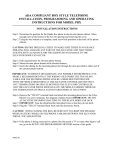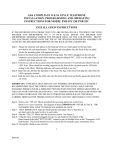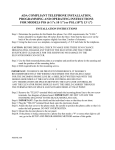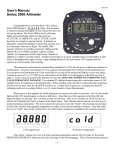Download Channel Vision TE-100 User's Manual
Transcript
1 YEAR WARRANTY 5 years with homeowner registration Channel Vision Technology will repair or replace any defect in material or workmanship which occurs during normal use of this product with new or refurbished parts, free of charge in the USA, for up to one year from the date of original purchase. This warranty does not cover damages due to shipping; failures caused by products not supplied by Channel Vision Technology; or failures due to accident, misuse, abuse or alteration of the equipment. This warranty is TE-100 Telephone Entry System extended only to the original consumer. A purchase receipt, invoice or other proof of original purchase date will be required before warranty repairs are provided. Mail in service can be obtained during the warranty period by calling 800-840-0288 toll free. A Return Authorization Number must be obtained in advance and marked on the outside of the shipping carton. This warranty gives you specific legal rights, and you have other rights (which vary from state to state). If a problem with this product occurs during or after the warranty period, please contact Channel Vision Technology, your dealer or any factory authorized service center. ),6&+(5$9(18(l&267$0(6$&$ ll)$; +773:::&+$11(/9,6,21&20l(0$,/6$/(6#&+$11(/9,6,21&20 &+$11(/9,6,21 TE-100 Telephone Entry System Channel Vision’s TE-100 provides a convenient and cost effective communication link between an entrance to every telephone in the house. Features include: • Sends a distinctive ring through the telephone to alert you to a visitors arrival • Sends a signal through the receiver if the phone line is already in use • Voice activated switching between the intercom and telephone (no buttons to push) • Can unlock two remotely located doors or gates • Interfaces with multi-room audio processors for whole-house paging • Works with lighted and non lighted doorbell buttons • Up to 1000 ft. distance to speaker, doorbell and strike • Connect 2 speakers in parallel for 2 door function Installation Step 1: Wiring the TE-100 to the house telephone line 1. Mount the TE-100 near the incoming telephone line junction box. 2. Connect the incoming telephone line into the J3 Telco Line Input Ports. 3. Connect the outgoing telephone line to the J2 House Phone Output Ports. Step 2: Wiring from the intercom zone to the TE-100 1. 2. 3. 4. Connect the pair from the speaker to the J6 “Speaker” terminal. Connect the pair from the doorbell button to the J4 “Doorbell” terminal. If utilizing a door strike, connect this pair to the J5 “Strike 1” terminal. A second door strike is available at J5 pin 3-4 location. If utilizing this second door strike, be sure to set switch S2 to the “Door” position. Step 3: Selecting your chime option After completing Steps 1 and 2, your TE-100 is set up to send a distinctive ring throughout the phone system once the doorbell is pressed. However, you also can select to have the doorbell chimes sound as well by following these steps (see diagram 2): 1. Locate the power transformer used for the existing doorbell chimes. 2. Wire one of the transformer leads directly to one of the doorbell chimes’ input terminals. 3. Connect the other transformer lead to the TE-100’s J5-5 chimes terminal. 4. Run a wire from the J5-6 chimes terminal to the available doorbell chimes terminal. You will now hear the doorbell chime and the phones ring when the doorbell button is pressed. 5. Check the S3 Chimes On/Off switch to be sure that it is set to On. You can disable the doorbell chime at any time by switching S3 to the off position. If necessary, the doorbell’s sound or “ding dong” delay can be adjusted by turning the TE-100’s R63 trimmer pot. Step 4: Interface with audio systems for paging The TE-100 includes a 600Ω balanced audio output for interfacing with multi-room audio systems. The Door Strike 2, J5 pins 3-4 are used for the audio output feature. 1. Place switch S2 into the “Page” position. 2. Wire from the J8 terminals to the audio input of the multi-room processor. 3. Next, make connections between J5 3-4 and the audio processor’s contact inputs. Step 5: Connecting the power supply Connect the 14VDC power supply that came with the TE-100 to the J1 input terminal. Operation The TE-100 is operated from the touch-tone keypad of any house phone connected to it. When the doorbell is pressed, the phones in the house will produce 3 short ring bursts. To speak to the visitor: Pick up the telephone handset and press (**). You are now connected to the intercom. You will notice that the speaker/microphone works in only one direction at a time. However, the telephone handset has the priority at all times during communication. Therefore, the homeowner can interrupt the visitor but the visitor can never interrupt the homeowner. If the phone is already in use: A high frequency tone (beep-beep) will sound in the receiver earpiece. These tones will continue until you press (**) to connect to the intercom. Once (**) is pressed the person that was on the line will be put on hold until you finish by pressing (#). Automatic Door Unlocking: The door strike relays are activated by pressing (*7) for door #1 and (*8) for door #2. Please note that the relay for door strike #2 is shared by the paging feature. If the paging feature is activated, door strike #2 will do nothing. Activating Paging Feature: Press (*5) to send the audio signal to the multi-room audio processor. Strike #2 will be activated @ the same time. Ending The Session: Pressing (#) ends the session and brings you back to where you were before the visitor pressed the doorbell button. Trouble Shooting: Loud noise or squealing at the speaker: This is caused by the speaker amp being turned up too high. Adjust R8 Speaker trim pot. Hear dial tone but nothing else works: The power supply is connected backwards. Reconnect it to the input terminal correctly. Phones ring weak or incorrectly: Too many phones are on the house line. Purchase a 15VDC 1 amp wall mount power supply. Line cuts off and goes to dial tone: This is caused by a high impedance telephone. See the enclosed information on High Impedance Telephones. Voice cuts out when speaking to the visitor: This requires careful adjustment of the sense trim. See the enclosed information on Speaker, Listen and Sense adjustments. Warning To prevent fire or shock hazard, do not expose this product to rain or moisture Speaker, Listen and Sense Adjustments: These adjustments allow the TE-100 to be to tailored differently for each installation. The factory settings should work well in most homes. The sense control may need special adjustment as it can be affected by outside noise and the level and type of voice that the user presents when speaking into the phone. The R8 SPEAKER adjustment sets the volume level for the front door speaker. It should only need adjustment when long runs of wire to the speaker are employed. Note that the TE-100 is designed to power speakers up to a distance of 1000 feet away. On short wire runs, the amplifier may oscillate if too much gain is used. If this occurs turn the speaker adjustment clockwise to reduce the volume level at the speaker. The factory setting is positioned at 3 o’clock. The LISTEN adjustment sets the volume level heard through the telephone. This should be set to 75% to 80% of maximum volume. Too much gain can cause the VOX circuit (the link between the visitor at the door to the inside telephones) to switch on its own. A clockwise adjustment decreases the volume through the ear piece. The factory setting is positioned at 7 o’clock. SENSE adjusts the sensitivity of the voice switching circuit. Depending on the setting, the switch may be more sensitive (responsive) to the visitor at the door or more responsive to the person speaking from the phone. In either case, if the setting is too little toward any side the speech will be "broken" and words (or parts of words) will become cut off. There is also an interplay between the listen control and the sense adjustment. If the listen adjust is set too high, it can affect the sense adjust because it is sending a level of sound from the speaker that exceeds the telephone signal. A counter clockwise adjustment decreases the amount of background noise. If set beyond the 6 o'clock position, the TE-100 may pick up too much outside noise such as cars passing by. The factory setting is positioned at 3 o’clock. The factory settings should work well in most cases. However, wire length, outside background noise and the placement of the speaker can all affect the overall system performance making some adjustments necessary. Speaker 3 O’Clock Listen 7 O’Clock Sense 3 O’Clock Switch Positions Chime ON-OFF: Doorbell operation. Page/Door: When switched to Page, Door Strike #2 will lock and hold until # is pressed or hang up occurs. Chimes Incoming Phone Line Chimes Duration: Allows you to increase or decrease the “ding dong” delay. Factory preset at the 9 o’clock position. Adjustment from 1 1/2 to 3 seconds. 9 O’Clock Out to Telephones Telephone Punch Down Block Ring ON-OFF: Turns the phone ringing feature On or Off. Strike Strike Adjustments: Factory preset at 1 second. Can be adjusted up to 3 seconds to match the requirements of the door strike being used. 9 O’Clock 15 VDC 1 2 3 4 1 2 3 4 - HOUSE PHONE OUTPUTS + TELCO LINE INPUTS High Impedance Phones: + - 1 DOORBELL - 2 STRIKE 1 + 3 SPEAKER PAGE OUT 110VAC Chimes Transformer CHIME JP-20 is located in the upper left side of the board and can be moved left and right. The default is in the right position for "normal" phones. Lift the jumper and place it across the two left pins. This should compensate for a high impedance phone. If there are other normal phones also connected to the line, JP-20 may have to be kept in the default position in order for all of the phones to ring correctly. Generally, when a high impedance phone is connected with a normal phone the "talk off" problem is improved. 4 STRIKE 2 - 5 + 6 CHIMES TE-100 Some phones draw very little current when used. These phones also produce an unusually high level of speech. These two behaviors can cause a problem called "talk off." If the user speaks loudly or blows into the phone, it may disconnect from the talking mode and go back to dial tone. If this happens, you have a high impedance phone and need to move jumper JP-20 on the circuit board. CVT 1UB/UHF-II (not included) ICU Series Intercom Camera Strike (not included) Please Note: High impedance telephones are typically the least expensive phones available. We recommend that all high impedance phones be replaced. + 12VDC Power Supply











